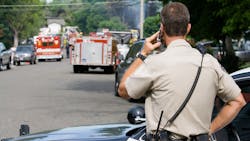Addressing the Gaps in Active Shooter Training: A Critical Need for Law Enforcement Agencies
In recent years, the United States has sadly witnessed a surge in active shooter/threat incidents[1]. In these situations, the role of law enforcement in responding quickly and effectively to neutralize the threat is absolutely vital. The initial moments of an active shooter event are incredibly intense, demanding a level of preparedness and quick thinking that's nearly unparalleled in the world of law enforcement. This article takes a dive into a significant issue within police training: the noticeable shortcomings of training for active shooter situations. It emphasizes the pressing need for a substantial update in current training approaches and underscores the significance of more frequent and highly efficient training programs.
Our Problem:
In recent weeks, I've had the privilege to engage in discussions with numerous law enforcement leaders across the country regarding the state of active shooter training within their respective agencies. Four themes emerged from these conversations: inconsistent training, narrowly focused programs, a lack of training and tools to assess officer critical thinking skills, and the inability to fill the gap between physical training periods.
- Inconsistent Training: The responses revealed a broad spectrum of practices, with some agencies conducting training sessions as frequently as four times a year, while others admit to a notable lapse in training activities since the outbreak of the COVID-19 pandemic. The inconsistency in active shooter training extends beyond the frequency of training sessions and encompasses the varying durations of these programs. It's striking to note that the training duration can range from as little as 2 hours to as many as 10 hours. Interagency training is also variable. Some agencies include neighboring law enforcement and medics while others train alone, rarely integrating a multi-agency response.
One factor contributing to this discrepancy is the availability of resources within each agency. Agencies with more substantial budgets, access to specialized training facilities, and trainers may have the means to conduct lengthier and more comprehensive training sessions. These extended programs allow for a more in-depth exploration of various scenarios, tactics, and potential challenges that officers might encounter during active shooter incidents.
Conversely, law enforcement agencies with limited resources may opt for shorter, less involved training programs due to budget constraints or scheduling conflicts. In such cases, the emphasis may be on providing essential skills and knowledge in a condensed timeframe, focusing on the most critical aspects of active shooter response.
- Narrowly Focused Training: A predominant theme emerging from discussions with law enforcement leaders is the rather narrow focus of active shooter training. Most often, interviewed law enforcement leaders reported they emphasize specific tactics, such as building clearance, medical integration, and first aid. Unfortunately, this neglects the broader context of active shooter incidents.
Moreover, a lack of critical thinking assessment means that officers may not develop the ability to adapt to the dynamic nature of active shooter incidents. This adaptability is crucial in responding to changing circumstances, such as evolving threat levels, shifting victim locations, and new information. Inadequate critical thinking can result in suboptimal responses and may even contribute to delayed actions that put lives at risk.
- Inability to fill the gap: The inability to bridge the gap between physical training periods is a serious challenge in the realm of law enforcement active shooter training. Physical training sessions may or may not be periodical, and there is often a significant time lapse between these sessions. One of the primary issues stemming from this gap is skill decay. The physical techniques and tactics taught during training sessions may erode over time, particularly if not consistently practiced and reinforced. Active shooter situations demand a high level of proficiency in firearm use, tactical movements, teamwork, and critical thinking. When officers are not regularly exposed to these elements, their effectiveness in responding to such incidents can diminish.
Furthermore, the gap between training periods can also lead to a lack of continuity in skill development. Officers may experience challenges in retaining the knowledge and skills they acquire during training, and this can result in a loss of confidence when they are called upon to respond to active shooter incidents. The dynamics of these high-stress scenarios can be overwhelming, and officers must rely on their training to react effectively. This gap can have far-reaching consequences, particularly when it comes to maintaining and improving the mental and physical skills needed by law enforcement officers.
A Solution:
To address the multifaceted challenges of training issues, police administrators must adopt innovative and forward-thinking solutions. Traditional training methods are no longer solely sufficient to prepare officers adequately for the complex and evolving challenges they face. In response to these issues, administrators must think outside the box, embracing new training paradigms and research-driven strategies.
One such research-based strategy is micro-learning. As of 2020, there were more than 400 studies underscoring the benefits of microlearning, this approach has proven highly effective in education[4]. Microlearning, characterized by short, focused, and easily digestible learning modules, has gained recognition for its effectiveness in a variety of educational and training contexts. Polls taken by ATD Research showed that most users found the ideal microlearning timeframe to be ten minutes- Lower Costs and Resource Requirements: One of the foremost reasons that agencies often curtail their training efforts is due to the financial expenses involved, the substantial resource requirements, and the logistical challenges associated with planning and scheduling training sessions. Traditional training methods often entail significant expenditures, including costs related to materials, scheduling conflicts, and overtime for officers. Microlearning not only increases training frequency but also offers a budget-friendly alternative for law enforcement agencies. These short, focused modules require minimal resources, and many can be created using existing materials and digital platforms, reducing the need for costly investments in physical training equipment or facilities.
- Increased Engagement: Microlearning is inherently engaging due to its brevity and focus. By leveraging microlearning modules that demand critical thinking skills, officers are drawn into the learning process with greater enthusiasm. This style of modules can present officers with real-world scenarios or decision-making exercises that necessitate the application of their cognitive abilities, fostering their problem-solving and decision-making skills. The short, interactive nature of microlearning keeps learners more engaged compared to lengthy, passive training sessions.
- Ease of Use: Microlearning content is designed to be easily accessible and user-friendly. This style of learning can come in many formats including verbal exercises, paper exercises, or e-learning formats. E-learning offers advantages such as portability and assignment management. Regardless of how microlearning is used, the content should be structured to be intuitive and straightforward, making it easy for officers to navigate and train.
How to use Micro-Learning:
In the realm of police training, microlearning represents a valuable approach that can be effectively implemented by trainers to bolster officer readiness and develop critical thinking skills. One practical way to incorporate microlearning is through the use of brief tabletop and decision-making exercises.
These exercises are designed to be compact, scenario-based learning experiences that can be completed in a short time frame. This style of training doesn’t have to be cumbersome for police supervisors. Instead of dedicating an extensive amount of time and resources to elaborate preparations and planning sessions, supervisors can adopt a more streamlined and effective approach to enhance critical thinking and preparedness in an active shooter situation. This approach involves creating a set of straightforward yet thought-provoking questions, which can be achieved by walking through potential issues and scenarios.
For example, officers may be asked to how they would respond to an active shooter incident and navigate challenges including prioritizing multiple injured individuals, communicating critical information effectively during the chaos of an incident, or how they would adapt their tactics if the shooter's location changes unexpectedly. These concise exercises enable officers to practice their critical thinking skills in a controlled environment and simulate real-world challenges.
Supervisors should craft these questions based on their understanding of the unique challenges and intricacies of an active shooter incident. When officers train, supervisors can assess the officers' critical decision-making abilities, confirm adherence to policies, and offer precise coaching within a controlled training environment. This proactive approach helps prevent real-world errors and enhances officers' overall performance.
Another benefit of microlearning is the ability to use this style of training with individuals of a group setting. Incorporating this style of training into a shift briefing can facilitate mutual learning among officers, allowing them to glean valuable insights from one another. This practice harnesses the collective years of decision-making experience within the agency, benefiting both the individual officers and the organization as a whole.
Conclusion:
A concerning training gap exists within law enforcement when it comes to effectively responding to active shooter incidents. The urgency to address this gap is paramount, given the escalating frequency of such events. A crucial step toward closing this gap involves embracing micro-learning, a dynamic and highly effective approach to training. Micro-learning, characterized by its brief and focused learning modules, offers a promising solution to the inconsistencies in active shooter training. It allows agencies to enhance their training frequency, improving officers' readiness and response capabilities.
Agencies should harness the power of micro-learning by incorporating tabletop exercises into their training regimen. These concise and scenario-based exercises encourage officers to think comprehensively about the entirety of an active shooter event. By focusing on the officer decision-making process, agencies can work to refine and enhance responses, ultimately leading to better outcomes during high-stress situations, and saving careers and lives.
[1] https://www.gunviolencearchive.org/past-tolls
[2] https://mpdc.dc.gov/sites/default/files/dc/sites/mpdc/publication/attachments/MPD%20AAR_Navy%20Yard_Posting_07-2014.pdf
[3] http://www.trbas.com/media/media/acrobat/2017-10/94837910-10093411.pdf
[4] Leong, Kelvin; Sung, Anna; Au, David; Blanchard, Claire (2021). "A review of the trend of microlearning". Journal of Work-Applied Management. 13: 88–102. doi:10.1108/JWAM-10-2020-0044. ISSN 2205-2062. S2CID 230579545.
[5]https://www.td.org/insights/just-how-micro-is-microlearning
About the Author
Ben Langham has been in law enforcement for nearly 22 years and is currently employed with the Kenai Police Department. As a Lieutenant, he serves as a training officer and the training supervisor for the agency. Ben is a graduate of FBI National Academy Session 268 and holds a master’s degree in Administration of Justice from the University of Alaska Fairbanks.
He is a co-founder of When Then Project, a company dedicated to improving police response to critical incidents and Active Shooter incidents. Through repeated microlearning with When Then Project, officers and supervisors are exposed to high risk/low frequency incidents, evaluate officer decision-making and improve overall responses.

Ben Langham
Ben Langham has been in law enforcement for nearly 22 years and is currently employed with the Kenai Police Department in. As a Lieutenant, he serves as a training officer and the training supervisor for the agency. Ben is a graduate of FBI National Academy Session 268 and holds a master’s degree in Administration of Justice from the University of Alaska Fairbanks.
He is a co-founder of When Then Project, a company dedicated to improving police response to critical incidents and Active Shooter incidents. Through repeated microlearning with When Then Project, officers and supervisors are exposed to high risk/low frequency incidents, evaluate officer decision-making and improve overall responses.




